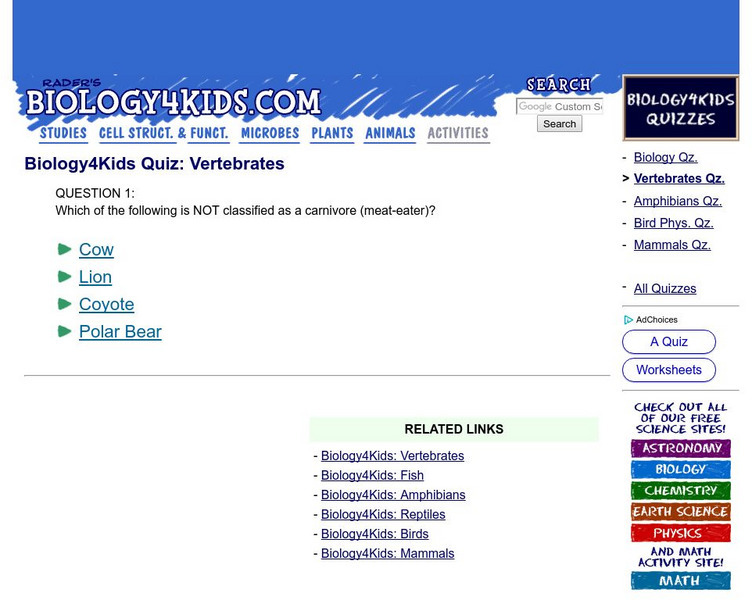Curated OER
Phylum Chordata
All major groups of vertebrates are summarized here with the characteristics of each explained. Other subphyla of chordates are listed: cephalochordata, urochordata, monotremata, marsupialia. The details are relevant but are not linked...
Curated OER
Campbell's Biology
Six chapters of a biology characteteristics of different domains xt are covered in this twenty-page assignment. Biology buffs chart the characteristics of different groups of organisms and address many critical-thinking questions...
Virginia Department of Education
Animal Phyla and Plant Divisions
Searched hours for an activity that allows individuals the ability to use multiple resources to learn about both plant and animal kingdoms? This discussion and activity provide pupils with the ability to visualize each organism...
Curated OER
Invertebrate Chordates
Most chordates are easy to identify because of the specific classification criteria of their phylum. But what about tunicates? Young scientists read a short explanation about why tunicates, or sea squirts, are considered to be members of...
Curated OER
The Chordates
Learners study the characteristics of organisms that are a part of the phylum Chordata. In this organisms lesson students identify mammals that are native to Saskatchewan.
Curated OER
Animal Kingdom: Phylum Chordata
Learners use a dichotomous key to classify various vertebrate jar speciments into classes. They examine the speciments for general characteristics of each class and fill in a corresponding chart and then complete a few final assessment...
Curated OER
Vertebrates
Students identify and describe five main groups of the Phylum Chordata. They discover that the Phylum Chordata is the vertebrates. Students identify the main difference between invertebrates and vertebrates. They read passages about...
Curated OER
Embryology as Evidence of Evolution
Students observe the two major developmental pathways (protostome and deuterostome). They analyze data regarding differences in nucleotide sequences and construct a phylogenetic tree. They observe the similar evolutionary history shared...
Curated OER
Creating My Personal Animal ABC Book
Students conduct Internet research on various animals. They write and create an Animal ABC book, including pictures of each animal, and each animal's phyla and class, to present to a young child.
Curated OER
Introduction to Animals
The details about invertebrates and invertebrates give valuable information about the characteristics of multicellular organisms. Examples of nutrition styles and symmetry are interesting. Also, these slides are clear in presenting a...
Curated OER
Classifying Commercial Marine Species
Students investigate taxonomy. They explore some of the commercial marine species caught in Magdalena Bay and develop a classification system for presented animals.
Curated OER
Invertebrates
In this invertebrate worksheet, students review characteristics of the different types of invertebrates. This worksheet places 32 vocabulary words into a crossword puzzle.
Curated OER
Diversity of Life
Students study Arthropods and their characteristics. In this organisms lesson students explore the success of Arthropods and answer questions.
Untamed Science
Untamed Science: Phylum Chordata
Learn about the characteristics, classification, and phylogeny that make the Phylum Chordata, a distinct animal classification group. See examples and photos of different species of chordates.
PBS
Pbs the Shape of Life: Phylum Chordata
From a PBS television series, this site offers a summary of the features which characterize the phylum chordata and includes multiple color photos.
Regents of the University of Michigan
Animal Diversity Web: Phylum Chordata (Chordates)
This site contains a listing of additional characteristics that many Chordates have in common beyond the typical four: notochord, dorsal nerve cord, pharyngeal slits, and a post-anal tail.
Sam Houston State University
Sam Houston State University: Chordate Characteristics
This site describes the characteristics of Chordates. There are also examples of two groups that show an affinity toward the phylum Chordata but do not actually exhibit the characteristics. This site also describes the history of the...
John Wiley & Sons
Wiley: Earth Through Time: Life of the Paleozoic: Phylum Chordata
Learn about the evolution of life in the Paleozoic Era based on fossil evidence of the five classes of fishes. Read about the role these chordates played in the evolution of tetrapods.
University of California
Ucmp: Introduction to Chordata
This site from UC Berkeley is an excellent site about the animal phylum chordata. Click on various sections to learn more, covering topics such as the fossil record, life history & ecology, systematics, and morphology. This site is a...
Untamed Science
Untamed Science: Biodiversity: Animals: Chordates: Amphibians: Class Amphibia
Explore the biodiversity of the Class Amphibia through videos, photos and examples. [2:34]
Untamed Science
Untamed Science: Biodiversity: Animals: Chordates: Birds: Class Birds
Through video clips and pictures, explore the orders and a variety of species found in the Class Aves.
Other
University of Aberdeen: The Phyla of Kingdom Animalia
Very systematic breakdown of the animal kingdom starting with the simplest type the sponge, all the way to the chordate or vertebrate. Each phylum has a link with information.
Other
University of Wisconsin La Crosse: Zoo Lab: A Resource for Animal Biology
A fantastic source of basic zoological information, a great supplement for all animal biology classrooms.
Biology 4 kids
Biology4 Kids: Quiz: Vertebrates
Take this ten-question review quiz over the Phylum Chordata. Read more about each question after an incorrect answer is given.























